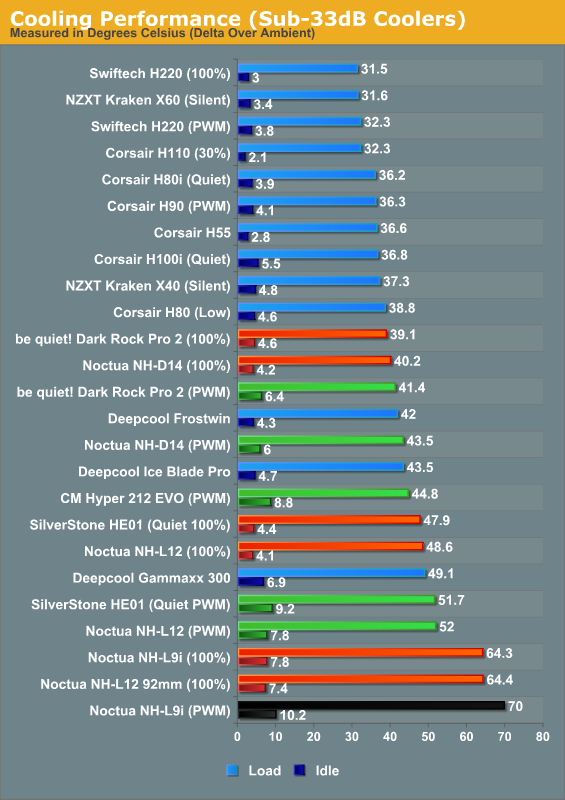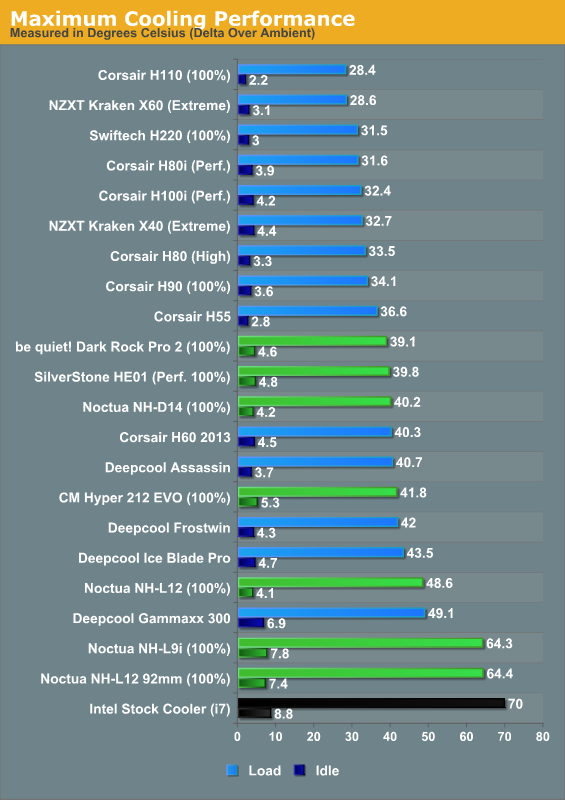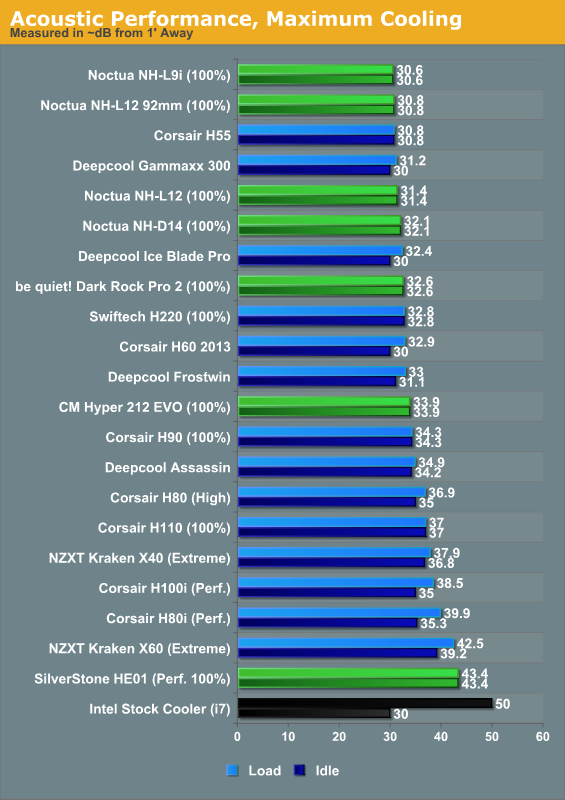CPU Air Cooler Roundup: Six Coolers from Noctua, SilverStone, be quiet!, and Cooler Master
by Dustin Sklavos on March 14, 2013 2:40 AM EST- Posted in
- Cases/Cooling/PSUs
- Cooler Master
- SilverStone
- cooling
- Noctua
- be
Silent Cooling Performance and Absolute Performance
Testing cases is in some ways much simpler than testing coolers, and a large part of that is because outside of an integrated fan controller, there's really not as much variability in the case's stock performance. Coolers, on the other hand, immediately benefit from the motherboard's fan control, and that has to be taken into account. They also have a more direct effect on the CPU's overall thermal performance. That means we need to break down the results into more useful metrics.
The first one is for silent performance. As a noise cap, I've chosen 33dB. Any coolers or settings that resulted in idle or load noise above 33dB have been pruned from the chart.

While every cooler I've tested today makes an appearance on this chart, the closed loop liquid coolers unfortunately have a clear advantage here. These are all quality units using excellent fans, though, and I'm keen to point out that you have to go to a 240mm or 280mm radiator before the closed loop units take a decisive lead. Generally speaking, you can get close to a 120mm or 140mm closed loop's cooling potential in an air cooler with comparable noise levels.
I'm keen to point out that Cooler Master's inexpensive Hyper 212 EVO actually does put in a pretty good showing here. Users on a budget would do well to note that it actually beats SilverStone's much larger Heligon HE01 when the Heligon's fan isn't cranked up.
With silent cooling broken down, let's take a look at the absolute maximum performance that can be gleaned from the coolers we've tested so far.

As it turns out, the closed loop coolers have a bit more headroom left in them compared to the majority of the air coolers tested. Our top performing trio is pretty much neck and neck for thermal performance, and even the Cooler Master Hyper 212 EVO is able to get awfully close to them. If you want high end air performance, you can definitely have it at a good price.

Of our big winners, though, Noctua and be quiet!'s solutions prove to be the quietest. SilverStone's Heligon may be able to produce comparable thermals, but that 38mm thick fan has to do an awful lot of grunt work to get there.










63 Comments
View All Comments
Touche - Thursday, March 14, 2013 - link
I agree. The test setup is bad and not representative of most real life configurations. So bad that the whole review is pointless.BrokenCrayons - Thursday, March 14, 2013 - link
I disagree. The coolers are measured under similar conditions and their performance in degress over ambient are listed. While seeing them in a real-world scenario might give you measurements that are more in line with a fully populated case, the variances introduced by the additional, unnecessary hardware might make it more difficult to get consistent, comparable results. I'm more concerned about relative performance and how coolers stack against one another and Anandtech's testing methods appear to be the best way to obtain those results without unreasonable expectations about controlled environment facilities.-BC
lever_age - Thursday, March 14, 2013 - link
Consistency and simplicity are good, but a procedure with a significant inherent bias is not (especially if this detail is not discussed by the reviewer... when it is not, it frankly seems like shortsightedness or incompetence, if not something worse). I rarely complain about testing procedures on most reputable review sites, but something is obviously flawed here. The results, which are out of line with most others', seem to indicate problems as well.There is nothing much that similar about how the air coolers and CLCs are being tested. The air coolers are being tested inside a relatively restricted box. The side-blowing towers are blowing towards a metal wall with some puncture holes from where the fan should be (also note the offset between holes and cooler, exacerbated by using a miniITX motherboard with socket unusually low). The CLCs are being tested with radiators and fans actually up against the openings in the chassis.
Actually, for that matter, it would be good to know exactly the orientation and placement of the radiators and fans for how the CLCs were tested.
Anyway, if you want a simplified setup, something more fair would be to just use an open-air test bench or no chassis at all.
Touche - Friday, March 15, 2013 - link
I was about to reply to BrokenCrayons, but you summed it up pretty well.BrokenCrayons - Friday, March 15, 2013 - link
An open air or open frame case might be a reasonable option. I hadn't really thought much about it and that's not a bad point. However, the net results -- the coolers in question all being tested in the same container -- would be the same. Honesty, Dustin could have stuffed all the hardware in a Tupperware container or a shoebox that used to have a pair of Nine & Co. Drama Print Peep-Toe Pumps in them and, as long as they were all under the same conditions, the result would be just as valid. Cooler effectiveness is a relative scale thing anyway since the conditions in which each person will use them are going to be unique to them. So many factors (room location, case exposure to sunlight, time of day, relative humidity, where you put your US Robotics ISA 28.8 data/fax modem, the number of Quantum BigFoot hard drives you have, etc.) impact a processor's operating tempratures that the testing methodology is trivial to the process of judging coolers as long as it remains consistent.Atop that, Intel ships perfectly usable coolers with their boxed processors. While I enjoy the reviews, if I want a faster CPU, I'll invest the extra $100 on a next-model-up CPU instead of a pointlessly chromed-out cooler or I'll wait until a faster CPU is brought to market or I'll just do something else with my computer. Obviously that's a personal preference and others might feel differently, but in the grand scheme of things, only a few people can be bothered to even care about the difference between a CLC, an aftermarket air cooler, and something that came out of the box or was included in it when the OEM put it together.
lever_age - Friday, March 15, 2013 - link
With regards to Intel's usable boxed cooler that's good enough for most people, I quite agree. However, they're not good enough for people who want to overclock significantly or want lower noise or temperatures or whatever; though the class of DIY builders who care about these things is small, they are relatively highly represented among AnandTech readers. Anyway, regardless of review subject material, if something's posted on AnandTech, it should be insightful and accurate, right?As for the other paragraph, I think you're misunderstanding an important point here, maybe because nobody really stated it explicitly.
If you test different cooling designs in different test setups, the relative rankings will be different. That's why the test configuration is an important consideration. I'm not so concerned by the absolute numbers reported. Dustin used a test setup that very much does not represent what most people would be using, and this setup favors the CLCs over the air coolers. Someone not realizing this will read the results and think that CLCs have better performance relative to the air coolers than what you'd get in the real world in most case configurations. It's highly misleading.
Or at least, that's what I believe based on reading others' test results and based on my intuition on the subject. If Dustin could prove me wrong and alleviate these concerns by retesting just a couple coolers on a different setup, I would be very appreciative and would promptly tuck the tail between the legs and run off.
lever_age - Friday, March 15, 2013 - link
(continuing... sorry, no edit feature exists I think)As an example of how test setup would affect results, consider two test setups:
A -- ATX-style case with strong front-to-back airflow, closed-off side panel with no mesh
B -- open-air test bench
Down-blowing CPU coolers would put up a better fight against side-blowing tower coolers in B than in A. Hopefully it is intuitive why.
inmytaxi@gmail.com - Saturday, March 16, 2013 - link
Then why'd you read the review?Tetracycloide - Sunday, March 17, 2013 - link
This:"the testing methodology is trivial to the process of judging coolers as long as it remains consistent."
Is only true as long as the coolers being tested are fundamentally similar. What you're saying is akin to claiming it's ok to test a custom water loop against an air tower without hooking the water loop up to the CPU block because "the conditions are the same." How is it a fair comparison if you're denying one solution's access to the medium by which it cools?
Azethoth - Tuesday, October 22, 2013 - link
No, you are missing the issue. Yes, you can see relative performance, but because of the test flaw you can only compare the air coolers to each other (accurately) and the water coolers only to each other but you have to keep in mind that their fans bias even their results yielding advantage to the CLC with the most airflow added by its radiator fans.To make it fair, you can possibly move the radiator outside the case and maybe run it in a hotbox that matches the test case interior.
Still, I think the only fair comparison is to add fans to the air coolers to match the radiator coolers as mentioned above. So you test CLC + radiator taking up vent space vs air cooler + extra fan taking up that same vent space.
So in practice I would expect this test to show that CLC are amazing and top performers. We see this. In fact the results made me look at the test method to see if the CLC were even allowed to reach equilibrium or not they seemed so skewed.
So good test for comparing only CLC to each other, or only AC to each other. Sucks for determining the true champions though because AC got shafted.